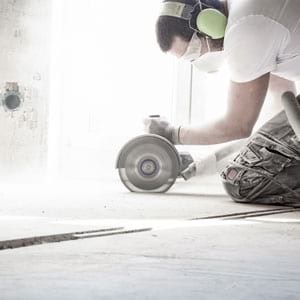Equipments
Noise
![]() CONTEXT
CONTEXT
Noise can be defined as unwanted or annoying sound. That is, noise is a subjective interpretation of sound that interferes with and disturbs the normal development of everyday activities. The same sound may be considered annoying or pleasant, de-pending on the hearer’s sensitivity or the activity they are carrying out.
Sources of noise may be internal or external and, generally, their impact (acoustic absorption) can be reduced by using absorbent materials. Acoustic comfort does not depend on the user, it depends on the building.
The relationship between excessive noise (environmental or in facilities or homes) and cardiovascular diseases has been proven in various studies. According to the WHO, the discomfort caused by noise may be considered to be a health problem. Other equally important effects associated with noise are the temporary or permanent impairment of hearing, irritability, disturbed sleep and interference in oral communication. These problems lead to a sensation of fatigue, reduced performance and concentration, and metabolic and nervous system effects.
Taking into account that acoustic quality is a fundamental aspect in the habitability of buildings, and indeed the most decisive one for the rest and comfort of their users, it is considered essential to incorporate acoustic criteria into the design and renovation of facilities.
![]() OBJECTIVE
OBJECTIVE
- Be familiar with the tools that guarantee acoustic comfort in facilities.
- Minimise unwanted noise and reduce noise from the exterior in order to benefit health, social interaction, satisfaction and productivity.
- Favour the use of sound absorbing materials to minimise reverberation and foster comfort.
![]() PROPOSALS AND RECOMMENDATIONS
PROPOSALS AND RECOMMENDATIONS
- Use the Application Guide for the CTE’s Basic Document on Protection against Noise (DB HR). The guide contains criteria for the interpretation of the DB HR, comments and application examples with the aim of providing support for technicians who participate in the building process, even if they are not familiar with acoustic concepts.
- Favour acoustic absorption by using open structure materials. The effect is proportional to their thickness and layout.
- Use acoustic false ceilings and/or sound-absorbent panels in transit zones and in the collective use spaces of the facilities.
- Conduct acoustic studies to enable the implementation of corrective measures when acoustic emission levels exceed regulatory levels.
- Sectorise the building in accordance with the acoustic needs of each space.
- Carry out exhaustive checks in the construction phase during the installation of light building envelopes (gypsum partitions, for example) to guarantee the correct sealing of all perimeters in order to prevent acoustic bridges.
![]() REFERENCE EXPERIENCES
REFERENCE EXPERIENCES
- “Mapa estratégico de ruido de la ciudad de Barcelona”. Ayuntamiento de Barcelona.
- The Center for Health Design. “Sound Control for Improved Outcomes in Healthcare Settings”.
![]() LEGISLATION
LEGISLATION
- Directiva 2002/49/CE del Parlamento Europeo y del Consejo de 25 de junio de 2002, sobre evaluación y gestión del ruido ambiental.
- Orden VIV/984/2009, de 15 de abril, por la que se modifican determinados docu-mentos básicos del Código Técnico de la Edificación aprobados por el Real Decreto 314/2006 y el Real Decreto 1371/2007.
- Real Decreto 1675/2008 de 17 de octubre, por el que se modifica el Real Decreto 1371/2007, de 19 de octubre, por el que se aprueba el Documento Básico «DB-HR Protección frente al ruido» del Código Técnico de la Edificación y se modifica el Real Decreto 314/2006, de 17 de marzo, por el que se aprueba el Código Técnico de la Edificación.
- Llei 16/2002, de 28 de juny, de protecció contra la contaminació acústica.
![]() STUDIES AND TECHNICAL DOCUMENTATION
STUDIES AND TECHNICAL DOCUMENTATION
- Santi Romero (2004) “L’Arquitectura de la Biblioteca. Recomanacions per a un pro-jecte integral”. Col.lecció “PAPERS SERT”. Col.legi d’Arquitectes de Catalunya. Accedit el 9-5-2019.
- Comisión de Edificación de AECOR (2015). Guia de rehabilitació acústica d'edificis.
- Evans, G.W. (2003). The Built Environment and Mental Health. Journal of urban Health 80(4):536-55.
- Codi Tècnic de l'Edificació (2016) Guía de aplicación del DB HR (CTE). Protección frente al ruido. Versión v.03. Ministerio de Fomento. Accedido el 9-5-2019.
- Junta de Andalucía. “Guía OSMAN. Ruido y salud”.
- Ministerio para la Transición Ecológica. Sistema de información sobre contaminación acústica (SICA).
- Ministerio de Trabajo y Asuntos Sociales (1998) NTP 503. Confort acústico: el ruido en oficinas. Guia de buenas prácticas.
- NVW editorial staff (2017). Reducing noise at the hospital. Noise & Vibration Worldwide 48(11):151-153.
- Observatorio DKV de Salud y Medio Ambiente en España 2012. “Revista núm. 3. Ruido y salud”.
More information about addressing the Public Health Service: entornurbasalut@diba.cat
Date of last update:
dl., 28 d’oct. 2019 15:33:30 +0000








 CONTEXT
CONTEXT 
 OBJECTIVE
OBJECTIVE  PROPOSALS AND RECOMMENDATIONS
PROPOSALS AND RECOMMENDATIONS  REFERENCE EXPERIENCES
REFERENCE EXPERIENCES  LEGISLATION
LEGISLATION  STUDIES AND TECHNICAL DOCUMENTATION
STUDIES AND TECHNICAL DOCUMENTATION 

